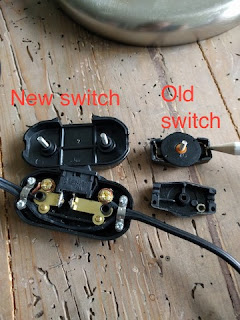How to investigate, diagnose, and repair a loose electrical switch
About a year ago (or more, who's counting at this point?) I found a lamp.Not just any lamp, but national name brand, cool art deco-ish shape, and brushed silvery color that actually matches some of the other lighting I own. Undinged, undingy, unhurt, and unclear why anyone throw this away. It even worked when I plugged it in with a bulb,
and then it didn't....
and then it did....
so ok, it was a bit fiddly depending on....something unseen.
Maybe the bulb? (no, that's fine)
Maybe the cord position? (seems to not like being moved, hmmm)
Why I decided to switch the switch
The unreliable connection led to concerns about there being a potential short somewhere, and a potential risk that should be fixed before I left the lamp plugged in. So I unplugged the lamp and set it on a shelf where it vaguely bothered me while sometimes fading into the background among other visual noise and ongoing projects. Then, whatever it is about spring that makes people clean and organize hit me. I was going to order supplies to rewire the whole lamp and started watching videos to try to learn what I would need. I learned that the switch type that sits on the cord is called on 'on line' or 'in line' switch, and the wheel-y version is known as a 'thumb wheel cord switch'.
Ah hah! Maybe that was something I could take apart and look inside of. If I saw a goblin inside chewing on the wire that would be an obvious diagnosis of what was causing the flickering.
 |
| What do you look like on the inside? |
So I opened it up. Just one tiny screw to open! No goblins though, just some switch innards.
Honestly the wheel switch apparatus seemed kind of rinky-dinky, with these little metal prongs that had to pierce through the cord, which they barely did. In the picture below I'm touching the prongs with a pencil. Those little brass pieces were part of a large curved piece that was not affixed to anything, one sort of fell out with a little help. Not a good idea for an electrical contact, just sayin'. Also the wheel mechanism didn't turn very smoothly. (Apparently as a result of this experience I'm becoming a bit picky about lamp switches.)
 |
| those little pointy bits are the supposed connection points |
How you can replace an on-cord electrical switch (always follow manufacturer's instructions)
I decided to try to replace the switch, the existing switch didn't look very robust (and maybe I had messed it up while opening it?) and that would be a cheap first repair diagnostic.
I found this more substantial looking switch at my local hardware store (cost approx $7.50). Although the entire assembly is larger the rocker switch seemed like a better solution than the wheel switch because there would be fewer moving parts. This little package came with directions. (If this is your first time replacing an in-line switch I highly recommend getting that option instead of the switch that comes in a baggie with no directions. Right???)
Here is a side-by-side comparison of the new (replacement) switch already installed and the old switch. The new switch had screws to hold the stripped ends of the wire in place, and a little clip on each end to hold the cord in place as it entered the housing. It just seemed better.
 |
| Out with the old and nonfunctional! |
Here are all the tools I ended up using:
-New replacement switch
-Wire cutter tool (already owned), sort of useful
-Scraping blade (since I couldn't find a razor blade to cut the cable, and the wire cutter tool wasn't doing exactly what I wanted)
-Pencil, for pointing, and pushing the cord wire under and around the screw
-Tiny screwdriver (already owned, essential)
 |
| The right tools make all the difference |
The final product is a functional switch and a lamp that I do NOT have to re-wire.
 |
| The future is looking bright! |
Happy freestyling! Electrical work still makes me nervous, but this was fun to learn and relatively easy to execute - my kind of repair (because it worked the first time).















